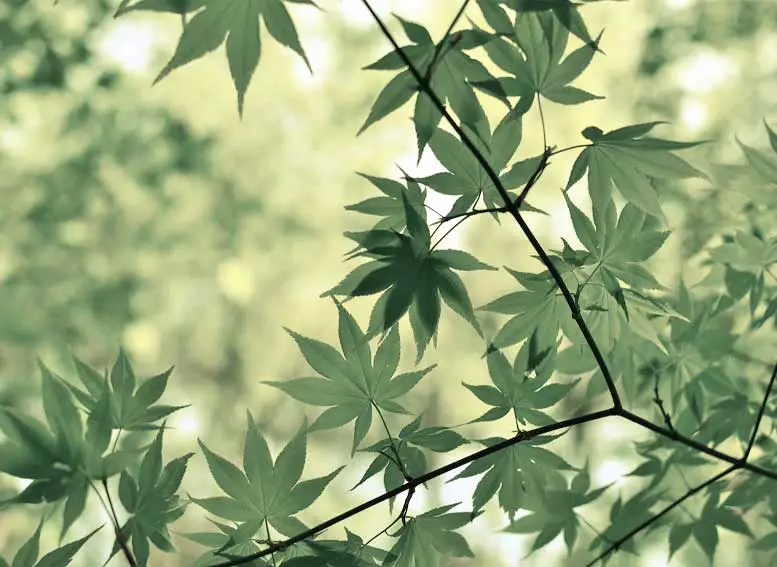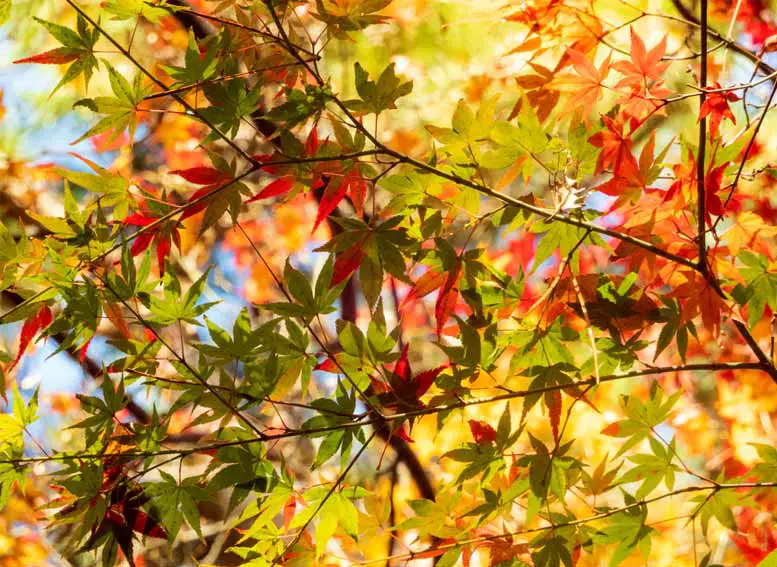Sango Kaku Japanese maple Acer palmatum is renowned for its most spectacular laceleaf adorns beautiful bright orange-red looks in spring. However, sango Kaku Japanese maple problems are caused by the pests like Japanese beetles and aphids, which gnaw away the leaves, and pathogens like fungal diseases Phytophthora or Verticillium wilt cause root rot.
The reasons behind the problem by the pests of Japanese beetles attracted by the smell emitted by the Japanese maple (like the Viridis and waterfall) and aphids sucking the sap of the leaves, and the pathogens proliferate in the moist soils and frequently rot the roots.
The solutions will be implemented from the perspective of pests and pathogens, where olive oil kill Japanese beetles, and neem or canola oil can kill aphids rapidly and proficiently; on the contrary, mulching is the ideal approach to eliminate pathogens in the soil.
Sango Kaku Japanese Maple Problems

Kaku Sango, the Japanese maple, is a beautiful garden decorative tree that conveys an elegant touch to the garden, especially in the spring. Nevertheless, the Japanese maple suffers from insect and pathogen invasions of the leaves and roots, where the pests chew away and extract the sap from the leaves, and the pathogens target the root level under the soil and rot the roots.
Other destructive pests include mites, mealybugs, and scales, mainly affecting young trees and trees of all ages. Predominantly they attack the leaves of trees (like olives), devouring or extracting the sap.
Again they proliferate on the leaves and gradually reach all the leaves of the tree, and after sucking and chewing, the leaves look like destroying. Because the Japanese maple grows slowly and is tall around 20-25 feet, the tree is frequently affected by pests.
A further dangerous problem with the Japanese maple tree is the pathogens attacking the root beneath the soil, rotting the root. The leaves progressively turn brown or yellowish; before death, the tree turns gray.
Pathogens such as the fungal diseases Verticillium wilt and Phytophthora attack the tree’s root and begin to decompose when the soil becomes clayed due to clogged water. The root undergoes drought stress and cannot provide water to the tree.
As a result of pathogen infestation, Japanese maple suffers dehydration and therefore turns brown. Due to a lack of water to nourish the tree, the Japanese maple gets damaged.
Reasons Behind Sango Kaku Japanese Maple Problems
The most prevalent reasons for the sango Kaku Japanese maple tree are leaf damage and root rot caused by harmful insects and pathogens. The major causes of the destructive assault on the Japanese maple are small in size, the leaves are attacked by beetles and aphids, and the root level is attacked by pathogens due to the damp condition of the soil and excessive mulch implementation.
Bettles and aphids such as mites, scale, or mealybug are dangerous for the trees; they attract to the leaves; they gnaw them away while others drain the sap from them. As a result, the tree’s leaves diminished over time.
Again, moist and soggy soil and an abundance of mulch provide favorable circumstances for pathogens. In such conditions, they proliferate, attack the tree’s roots, and severely damage them.
Solution of Sango Kaku Japanese Maple Problems
The solution to Japanese maple problems is to deport the beetles and aphids and create circumstances not to affect them again. So, there is a good solution; you can get rid of the aggression from beetles and aphids.
Watering Regularly and Apply Insecticide
Regular watering can wash away beetles, aphids, insects, and darts. Furthermore, microbiological insects live in the pores of the leaves, which are washed away by regular watering.
Avoid using insecticides unless there is a major pest infestation. Insecticidal soap is safe for the environment, alcohol solutions kill aphids, and other pesticides kill pests.
Precautionary Measures
To avoid aggression, apply olive oil to the leaves, which kill Japanese beetles, and neem, or canola oil can kill aphids rapidly and proficiently. Applying these is one of the most remedies for the tree.
Apply Mulch to The Soil
Applying mulch to the soil is the ideal approach to eliminating pathogens. Perfectly and adequately using mulch is better for the soil, enhancing fertility (by using fertilizer balls) and sustaining the soil’s capability.
Leaf mold or plenty of fertilizer is better for the soil drainage advantage and efficaciously mitigates the aggression of pathogens such as Verticillium wilt or Phytophthora to prevent root rot.
Pluck Out The Affected Leaves
Detecting the pests and aphids that have affected the leaves is essential. Pests eat the leaves, while aphids drain the sap from them.
The leaves are unable to recuperate after the onslaught. So, removing the infected leaves is a better strategy to avoid infecting other leaves.
Proper Soil Drainage System
The soil needs a proper draining system to avoid clogged water beneath the Japanese maple tree. Clogged water is so much dangerous for the soil condition, dampens the soil, and creates circumstances for the proliferation of pathogens.
Care About Over Watering
Watering is so much adequate to remove away the pests, aphids, and other insects, but over watering also creates some favorable conditions for the pests. Sometimes water accumulates leaves or stems of the Japanese maple tree, which is advantageous for pests and aphids.
Again, over watering clogged water beneath the tree, the soil can’t consume all the water. Then the soil becomes damp and soggy, where the pathogens proliferate well. Pests produce honeydew in the leaves, which attracts the molds.
Clean The Garden and Surroundings
The surrounding environmental conditions are highly susceptible to insects or pests impacting the trees. You must remove the weeds; affected trees must be unleashed to cleanse the garden.
Pests and aphids are primarily impacted by nearly afflicted trees. As a result, the best treatment for Japanese maple problems is to first clean the garden and surroundings.
Cultivate Soil Regularly
Soggy soils are ideal for the growth of fungal diseases. Pathogens thrive in saturated soil, which may be reduced by cultivating the soil regularly.
Pathogens may live in primitive soils, and cultivating soil is one of the best approaches to get rid of them. It also improves the viability and fertility of the soil.

Abstract of Japanese Sango Kaku Maple Problems
Sango Kaku Japanese maple recognizes most outstanding vivid hues, where some problems snatch away the beauty of this tree. Remarkably, the leaves become fragile, curl, or are damaged by pests such as Japanese beetles and aphids.
Again, root rot is another major issue of Japanese maple by the root attack in the soil by fungal pathogens such as Verticillium wilt and Phytophthora, where pathogens cause root rot drastically.
The pests are drawn to the tree by the fragrance and remain on the leaves; they are destroyed by chewing or sucking sap from the leaves, and the damp condition of the soil is liable for the aggression of pathogens.
Without taking prior remedies, it is so tough to keep away from pests and pathogens. The solution will be adopted in terms of pests and pathogens, with olive oil to kill the beetles, neem, or canola oil to eliminate aphids, and mulching and cultivating the soil regularly is the best way to eradicate pathogens.
A short video on sango Kaku Japanese maple:
FAQs on Japanese Maple Problems
Q1. What is the major problem behind Japanese maple dying?
Ans: The major problem behind Japanese maple dying is the aggression of pests and aphids on the leaves and pathogens to the root.
Q2. What is the solution to the Japanese maple leaves problem?
Ans: Apply olive oil, neem, or canola oil to the leaves to protect them from pests and aphids.
Q3. What is the solution to the Japanese maple root rot problem?
Ans: Apply adequate mulch to the soil, cultivate soil regularly, and keep a proper drainage system.
Q4. What is the effective way after affecting to Japanese maple tree?
Ans: After affecting by pests or aphids to the leaves, pluck out the leaves and apply the alcoholic solution, insecticidal soap.
Q5. What are the signs when the root of the Japanese maple tree is affected?
Ans: It’s pretty challenging to identify a pathogen’s attack, but if the leaves turn yellow (like lily) or brown, you need to take steps to keep the soil condition against pathogens.
Q6. What is the effective way to affect the roots of the Japanese maple tree?
Ans: After being affected by fungal pathogens, apply adequate mulch to the soil and cultivate the ground properly.

I’m Shofi, a passionate gardener and blogger. I have 10+ years of experience in gardening and hold certifications in horticulture and garden design. I share my knowledge and skills through my garden blog to inspire and educate others on the joys of gardening. I try to provide valuable information and create a community for gardeners of all levels to connect and learn. My ultimate goal is to inspire others to start their own gardens and connect with nature.

